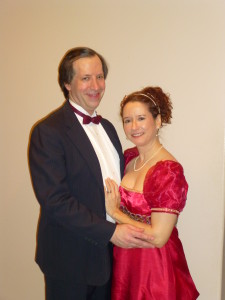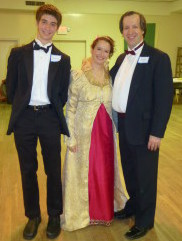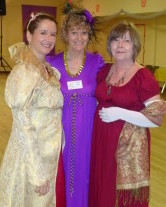To dance at a ball…
Balls and assemblies form a regular feature of Georgian and Regency era historical novels. Often heroes and heroines meet, dance, flirt, fight, and even fall in love on the ballroom floor. But what was it really like to attend a ball? Recently I got to find out first hand.

My husband, eldest son and his wife, youngest son and I joined an English Country Dance group, a couple of months before their big spring ball event. We attended two balls in the course of just a month. The experience offered a wealth of perspective on the myriad ways that period heroes and heroines might interact on a ball room floor, not to mention we had a whole lot of fun in the process.
Getting Ready for the Ball
The fun began with dressing up. You can’t go to a ball without dressing up, right? Well, the guys had it easy. They put on their tuxes and were ready to go. If only it was so simple for me! My period ball gown, made for an event last year, had to come out of storage and be pressed.
Oh, shoot! Totally forgot that it took a little damage when the train was stepped on, so out comes the mending kit. While I’m mending, I’d better add some means to fasten up the train so it won’t get stepped on again! Rats, the pelisse that goes with it needs some work too. Where is the lady’s maid when you need her?
And the hair! Oh, the hair! What was I going to do with it and how much time did I have to do it in? Definitely not enough. I confess, some decidedly non-Regency products went into the making of the hair. I’d never have gotten out of the house without an electric hair drying and curling iron. Note to self, it takes a LONG time to get ready for a ball.
Once dressed and made up, we had to figure out how to get all of us, plus my dress in the car, without crushing everything. Luckily, I was traveling with a professional engineer and his apprentice who rose to the challenge. Even more fortunate for me, they were there to extract me from said vehicle when we arrived. Once out of the car, the parking lot offered another challenge. After days of rain, puddles and mud threatened to spatter the gown and redingote. Trying to pick up all the skirts and ruffles and train to keep them out of harm’s way proved another unexpected hurdle. The whole experience made me very sympathetic for the ladies who had to travel to a ball in a carriage and then cross dirty roads in the wake of the horses while keeping their gowns clean.
Everyone Needs a Partner
When we arrived at the ball, the number of unfamiliar faces was a little overwhelming. Dancers from all over our region were coming together for the event. Definitely a bit intimidating, especially since we’d only been dancing for a few months. I have to imagine this feeling was familiar to the dancers of the Regency era as well. There was no way to predict what new faces might appear at a public assembly for which anyone with the blunt could purchase a ticket. A young lady’s chaperone had to be very watchful at such an event as there was no telling what quality of person might ask for a dance. Private balls, which required a personal invitation, were far more predictable in the quality of attendees.
To start the dance, the Master of Ceremonies (today the position is known as the caller) advised everyone to find a partner. In the era, a gentleman could not ask a lady to dance unless they had been formally introduced. A chaperone, other acquaintance, or Master of Ceremonies could introduce potential dance partners during the ball to enable them to dance together. Couples, unless engaged or married, did not dance more than two dances together, so many partners might be required for an entire evening of dance. In our particular dance group, even married couples are expected to change partners with each dance, so partners many partners are required for an entire evening of dance. Given what I know now about how much might be communicated on a dance floor, I can understand why chaperones might want to control who could ask their charge for a dance.
Having brought my own partner with me, and an extra to boot in the person of my son, I had hopes that I would be able to dance every set. Even so, it was not guaranteed. To be honest, waiting (and hoping) to be asked to dance each set wasn’t easy, especially since there were so many people I did not know. Since women outnumbered the men, the Master of Ceremonies allowed women to dance with other women, clearly not a desirable situation, but better than having so many people sitting out.
The same occasionally happened in the Regency era, when the Napoleonic wars left young men in short supply. Jane Austen mentioned this situation when in Pride and Prejudice. Mr. Bennet upbraids Kitty that she might not attend another assembly unless she ‘stands up with her sisters.’ In other words, she would be restricted to dancing with her sisters only, a sad fate for the poor girl.
Even so, in our case, permitting everyone able who wished to dance was a better alternative than having people forced to sit out. It did get confusing, though, when the caller would instruct the men to do a particular step, and I had to scramble to remember which part I was dancing.
Although seemingly simple, the way one might be asked to dance could speak volumes. The offer might be made with eye contact and a quick gesture toward the dance floor; a smile, a bow and flowery words; a sweaty palmed, stammered request; or even a shrug and an eye roll of ‘well, I suppose you will do.’ All these offers set and color the stage for a series of silent communications on the dance floor.
Once dancers paired up, the caller announced the dance and what required formation: circle, lines, groups of three or four couples. The modern caller guides the dancers through the steps, not unlike a square dance caller, however, in the past this was not done. Dancers were expected to know all the steps to all the dances. How was it possible for dancers to know the steps to all the dances that might have been called? It sounds like a daunting and overwhelming task.
During the period, yearly dance books like Preston’s 24 Country Dances for the Year 1803 were published containing the music and dance steps for that year. Dance masters would use those books to teach their students the year’s dances. This helped insure common and well-known dances would be performed at public assemblies.
Preston’s 24 Country Dances for the Year 1803
Join me for the next part in this series for a closer look at the specific dances we danced and a look at the interactions from the ballroom floor.

what a great article Grace! You lead such a rich full life! And you look so beautiful in your Regency gown!
I went to three Regency balls this past year, so I know the thrill and anxieties of which you speak. However at our balls, men had to have period costumes, too. No tuxes! We had wonderful military uniforms and sombre gentlemen’s outfits that Mr Collins might have been at home in, but never looked half so dashing in. We women were amazed at all the men who came – in my little circle of friends, not one husband could be lured to the event, but many young men were there and in costume to dance with their wife, intended or girlfriend. Or mother!
I hope your writing about the ball will encourage more people to try English Country Dancing (or Scottish Country Dancing) and – as the next step – treat themselves to a ball. Nothing like partying like it’s 1815, I always say!
Sounds daunting already.
Read this on your other posting.
Thanks, Sheila!